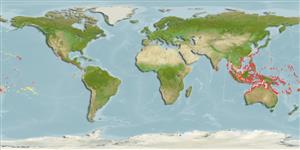Preferred temperature (Ref.
115969): 25.1 - 29, mean 27.9 (based on 648 cells).
Phylogenetic diversity index (Ref.
82804): PD
50 = 0.5000 [Uniqueness, from 0.5 = low to 2.0 = high].
Bayesian length-weight: a=0.00490 (0.00187 - 0.01281), b=3.11 (2.88 - 3.34), in cm Total Length, based on LWR estimates for this (Sub)family-body shape (Ref.
93245).
Trophic level (Ref.
69278): 3.3 ±0.44 se; based on food items.
Fishing Vulnerability (Ref.
59153): Low vulnerability (10 of 100).
